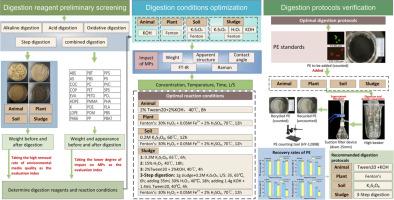当前位置:
X-MOL 学术
›
Water Res.
›
论文详情
Our official English website, www.x-mol.net, welcomes your
feedback! (Note: you will need to create a separate account there.)
Comprehensive assessment of various digestion protocols for extraction microplastics from organic-rich environmental matrices
Water Research ( IF 11.4 ) Pub Date : 2025-05-30 , DOI: 10.1016/j.watres.2025.123935
Kaiyou Huang, Linyang Xie, Xueyuan Gu, Junying Xie, Jiapeng Li, Shixiang Gao, Rong Ji, Dongmei Zhou
Water Research ( IF 11.4 ) Pub Date : 2025-05-30 , DOI: 10.1016/j.watres.2025.123935
Kaiyou Huang, Linyang Xie, Xueyuan Gu, Junying Xie, Jiapeng Li, Shixiang Gao, Rong Ji, Dongmei Zhou

|
Digestion plays a vital role in extracting microplastics (MPs) from organic-rich environmental matrices (OEMs). The diversity of MPs and OEMs complicates the application of a unified digestion reagent to various environmental media. In this study, we comprehensively evaluated the efficiency of removing organic matter (OM) from four typical OEMs (animal tissue, plants, soils, and sludges) using 27 digestion protocols through a preliminary screening experiment followed by optimization of digestion conditions (such as concentration, time, and temperature). Moreover, the impact of the digestion protocols on 26 types of MPs was examined to ensure minimal alteration in their morphology, weight, contact angle, surface functional groups, and backbone structures. The optimized digestion protocol for each OEM is as follows: 2% KOH at 40°C for animal tissue; Fenton’s reagent at 60°C for plants; 0.2M K₂S₂O₈ at 60°C for soil; and a three-step protocol for sewage sludges (0.2M K₂S₂O₈ at 65°C, 15% H₂O₂ at 40°C, and 2% KOH at 40°C). These protocols achieve the highest removal rate of OM while minimizing the impact on the 26 MPs. Finally, the methods were validated by adding 75-95 μm standard polyethylene (PE) spherical particles into the tested natural OEMs. A custom-made counting device integrated with a computer-assisted counting method was employed to ensure complete retrieval of these added particles. The proposed digestion protocols resulted in recovery rates of 98.9±1.2% (animal tissue), 85.5±0.9% (plants), 74.9±3.5% (soil), and 82.7±2.3% (sludge). Our results offer an essential reference for the establishment of standard MPs extraction methods from complex environmental matrices.
中文翻译:

全面评估从富含有机物的环境基质中提取微塑料的各种消化方案
消解在从富含有机物的环境基质 (OEM) 中提取微塑料 (MP) 中起着至关重要的作用。MP 和 OEM 的多样性使统一消化试剂在各种环境介质中的应用变得复杂。在这项研究中,我们通过初步筛选实验,然后优化消化条件(如浓度、时间和温度),使用 27 种消化方案全面评估了从 4 种典型 OEM(动物组织、植物、土壤和污泥)中去除有机物 (OM) 的效率。此外,还检查了消化方案对 26 种 MP 的影响,以确保它们的形态、重量、接触角、表面官能团和骨架结构的变化最小。每个 OEM 的优化消化方案如下:动物组织在 40°C 下 2% KOH;60°C 的 Fenton 试剂,用于植物;土壤在 60°C 时为 0.2M K₂S₂O₈;以及污水污泥的三步方案(65°C 时 0.2M K₂S₂O₈,40°C 时 15% H₂O₂,40°C 时 2% KOH)。这些方案实现了最高的 OM 去除率,同时最大限度地减少了对 26 MP 的影响。最后,通过将 75-95 μm 标准聚乙烯 (PE) 球形颗粒添加到测试的天然 OEM 中来验证方法。采用与计算机辅助计数方法集成的定制计数装置,以确保完全检索这些添加的颗粒。拟议的消化方案导致回收率为 98.9±1.2%(动物组织)、85.5±0.9%(植物)、74.9±3.5%(土壤)和 82.7±2.3%(污泥)。我们的结果为从复杂环境基质中建立标准 MPs 提取方法提供了重要的参考。
更新日期:2025-05-31
中文翻译:

全面评估从富含有机物的环境基质中提取微塑料的各种消化方案
消解在从富含有机物的环境基质 (OEM) 中提取微塑料 (MP) 中起着至关重要的作用。MP 和 OEM 的多样性使统一消化试剂在各种环境介质中的应用变得复杂。在这项研究中,我们通过初步筛选实验,然后优化消化条件(如浓度、时间和温度),使用 27 种消化方案全面评估了从 4 种典型 OEM(动物组织、植物、土壤和污泥)中去除有机物 (OM) 的效率。此外,还检查了消化方案对 26 种 MP 的影响,以确保它们的形态、重量、接触角、表面官能团和骨架结构的变化最小。每个 OEM 的优化消化方案如下:动物组织在 40°C 下 2% KOH;60°C 的 Fenton 试剂,用于植物;土壤在 60°C 时为 0.2M K₂S₂O₈;以及污水污泥的三步方案(65°C 时 0.2M K₂S₂O₈,40°C 时 15% H₂O₂,40°C 时 2% KOH)。这些方案实现了最高的 OM 去除率,同时最大限度地减少了对 26 MP 的影响。最后,通过将 75-95 μm 标准聚乙烯 (PE) 球形颗粒添加到测试的天然 OEM 中来验证方法。采用与计算机辅助计数方法集成的定制计数装置,以确保完全检索这些添加的颗粒。拟议的消化方案导致回收率为 98.9±1.2%(动物组织)、85.5±0.9%(植物)、74.9±3.5%(土壤)和 82.7±2.3%(污泥)。我们的结果为从复杂环境基质中建立标准 MPs 提取方法提供了重要的参考。


















































 京公网安备 11010802027423号
京公网安备 11010802027423号